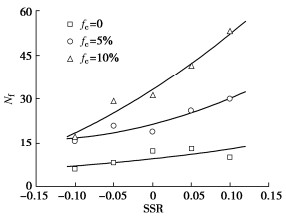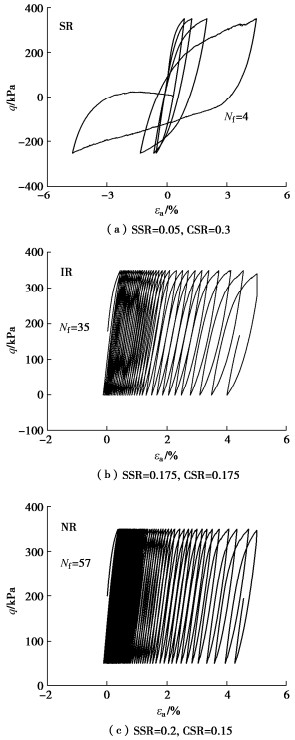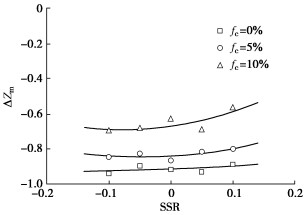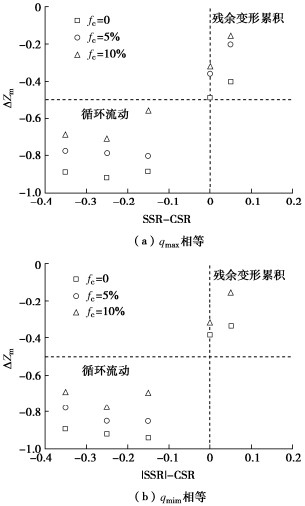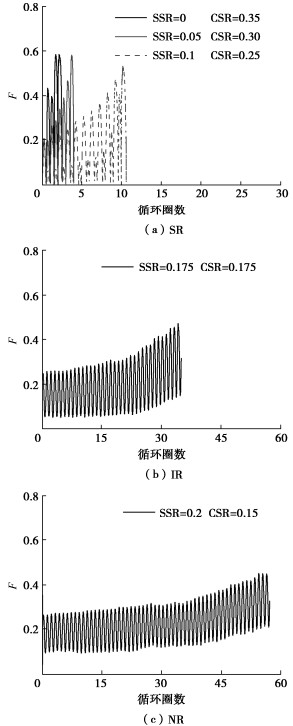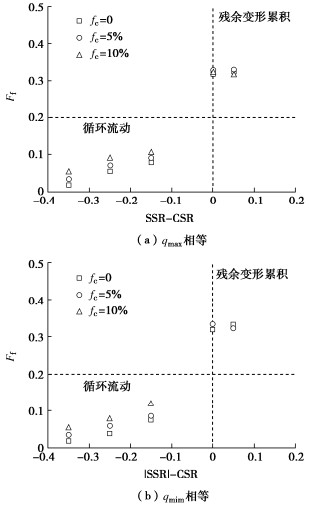Cyclic liquefaction behavior of silty sand considering initial static shear effect: a DEM investigation
-
摘要: 为研究含细粒砂土液化行为的微观机理,采用颗粒流程序PFC3D模拟了砂土在不排水循环荷载下液化特性,将含有少量细粒的砂土试样与净砂在相同初始状态参数下的循环响应进行了对比,研究了初始静剪和细粒含量对砂土动力液化特性的影响。模拟结果显示,不同静剪应力条件下,含细粒砂土呈现出两种典型的液化破坏模式:循环流动和残余变形累积。当试样表现为循环流动型响应时,配位数逐渐减小至4;而当土体破坏由残余变形累积导致时,配位数变化较小且组构模量始终大于0。相同初始状态和应力条件下,含细粒砂土在循环加载过程中的配位数变化量较净砂大,其抗液化能力也相应较大。此外,随着静剪应力增加,试样的配位数变化量逐渐增大,其抗液化动强度也随之增大。Abstract: To gain more insights into the microscopic mechanism of the liquefaction behavior, the particle flow program PFC3D is used to simulate the liquefaction process of silty sands under undrained cyclic loading. The effects of the initial static shear stress and fines content on the cyclic liquefaction behavior of sand are investigated. The simulation responses of silty sand containing a small amount of fines are compared with those of clean sand under the same initial state parameters. The simulated results show that regardless of the fines content, different initial static shear stress conditions can result in two liquefaction failure patterns: cyclic mobility and residual deformation accumulation. Generally, the samples exhibit cyclic mobility accompanied by a decrease in the coordination number. The coordination number of samples under residual deformation accumulation changes slightly, while the fabric norm F is always greater than zero as the cyclic shearing proceeds. Under the identical initial state and stress conditions, the coordination number variation of fine-grained sand during cyclic loading is larger than that of clean sand, and its liquefaction resistance is also larger. Furthermore, a higher initial static shear level leads to a larger change in the coordination number and also an increase in the cyclic liquefaction resistance.
-
0. 引言
砂土广泛分布于沿海及冲积平原地区,是道路路基填筑、边坡支护、铁路轨道道砟及防洪堤坝等工程中常用的建筑和地基材料。蔡袁强等[1]指出含细粒砂土是可液化场地中最典型的土体类型。在实际工程中,斜坡下的土体单元在经历交通荷载、波浪荷载、地震作用等循环荷载前,往往存在初始静剪应力。在考虑初始静剪作用的循环加载试验中,一般根据初始静剪应力τs和循环剪应力τcyc的相对大小,可将加载模式分为以下3种[2]:|τs|<τcyc时,为“应力翻转”加载模式(stress reversal, SR);|τs| = τcyc时,为“中间应力翻转”(intermediate reversal, IR);|τs|>τcyc时,为“无应力翻转”(no reversal, NR)。已有研究表明初始静剪对土体的抗循环液化能力有十分显著的影响,且与围压、密实度等因素有关[3-6]。在以上因素的共同作用下,初始静剪对砂土抗液化能力的影响并不明确,既有可能增强[7],也有可能削弱[8],与土体的初始状态有关。
除初始静剪作用外,细粒含量会显著影响土骨架结构和内孔隙排布,从而影响土体剪胀性、组构特性、临界状态以及静动力液化行为[9-10]。已有研究多选取孔隙比e、相对密实度Dr和等效骨架孔隙比es, eq等指标作为控制条件,来研究细粒含量对砂土抗液化能力的影响。研究表明,e相同时含细粒砂土的抗液化能力随着细粒含量增大先增大后减小[11];相对密实度Dr一定时,砂土抗循环液化能力随着细粒含量的增加保持不变或有所增大[12];而当等效骨架孔隙比es, eq一定时,细粒含量增加会降低砂土的抗液化强度[13]。可见,细粒含量对砂土抗液化能力的影响也未能达成一致,左康乐等[14]指出造成该现象的原因可能在于控制指标的选取。
以上研究多关注土体宏观力学特性,而砂土作为一种离散体,其宏观响应很大程度上取决于土体内部结构的演化。因此,国内外学者们广泛采用基于非连续介质力学的离散单元法(DEM)开展砂土微观力学特性的研究。Zhang等[15]模拟了颗粒材料在不同初始静剪水平下的不排水循环单剪试验,发现初始静剪对液化强度的影响是预剪切期间稳定性降低和循环加载期间剪切应变累积共同作用的结果。Dai等[16]通过DEM研究了含细粒砂土在剪切过程中颗粒排布和粒间接触,从细观方面解释了细粒在砂土液化中发挥的作用。Gong等[17]和王涛等[18]进一步指出细粒含量的变化会引起土体接触类型的改变,进而对土体骨架结构、配位数和荷载传递模式产生影响。综上所述,开展对砂土在初始静剪作用下的力学特性细观分析有助于深入理解复杂应力条件下的砂土宏观力学行为,进一步明确含细粒砂土的动力变形与破坏机制。
目前,考虑初始静剪作用的含细粒砂土离散元模拟研究工作尚不多见,本文通过颗粒流程序PFC3D,制备了不同细粒含量的砂土试样,进行了多种静剪应力水平下的不排水循环三轴模拟试验,从宏微观的角度分析了细粒含量和初始静剪对砂土抗循环液化能力和变形模式的影响。
1. 试样制备及方案
1.1 试样制备
含细粒砂土试样由粗颗粒和细颗粒组成,净砂试样则全部采用粗颗粒。ASTM标准[19]中建议试样的尺寸与最大颗粒粒径之比大于6,结合此标准及已有的数值模拟研究[20],拟定试样尺寸为6.5 mm×6.5 mm×6.5 mm,组成试样的粗颗粒直径在0.3~0.5 mm服从均匀分布,细颗粒直径为0.067 mm,级配曲线如图 1所示。根据细颗粒占试样总质量的比例制备细粒含量fc = 0,5%,10%的3种试样,其颗粒数量均在5000以上。
试样采用半径扩展法生成,具体步骤如下:①生成边长为6.5 mm的立方体边界墙体;②依据目标孔隙率计算颗粒数量并在区域内按目标直径的1/2随机生成不重叠的球颗粒;③将所有球颗粒的半径扩大为目标直径;④删除超出墙边界的颗粒。本研究的不排水三轴加载过程由伺服机制控制,通过调整竖向固结应力σv和水平固结应力σh来实现不同初始静剪应力条件的模拟;循环荷载采用应变控制式加载,波形为正弦波,通过对试样的上下边界墙体施加相应速度,使施加于试样的正应力达到目标应力条件,以实现对试样的等应力循环加载。加载过程中通过控制惯性数I < 10-3来维持数值模拟的准静态条件,并且在最大的颗粒不平衡力与平均颗粒间接触力的比值小于0.001时才对试样进行加载。惯性数的表达式为[21]
I=gγd√ρ/p。 (1) 式中:gγ为应变加载速率;d为颗粒的平均直径;ρ为颗粒密度;p为平均有效正应力。本研究的应变加载速率为0.001 s-1,计算得出的最大惯性数Imax = 9.12×10-7,满足准静态加载要求。
为了兼顾计算效率与模拟结果的准确性,本文采用线性接触模型进模拟,法向刚度、切向刚度等模型细观参数的设置见表 1。相同的模型参数已在真三轴、循环单剪和扭剪等模拟试验中得到应用[22],并与相应的室内试验[23]进行了对比,如图 2,试样的剪胀(剪缩)、应变硬化(软化)特性在离散元模拟均反映良好。
表 1 数值模拟参数Table 1. Parameters for numerical simulation颗粒密度ρ /(kg·m-3) 法向刚度kn/(N·m-1) 切向刚度ks/(N·m-1) 颗粒间摩擦系数μ 阻尼比
β2600 105 105 0.5 0.7 1.2 试验方案
本研究选用初始状态参数作为研究初始静剪对砂土液化特性影响的控制指标。初始状态参数ψ0的概念由Been等[24]提出,指初始孔隙比与在相同平均有效应力条件下的临界孔隙比的差值,即
ψ0=e−ec。 (2) 式中:e为当前孔隙比;ec为当前有效应力p′对应的临界状态孔隙比。
在开展循环模拟前,先进行了一系列单调剪切三轴试验,获得了不同细粒含量砂土试样的临界状态线以计算ψ0,如图 3所示。虽然细粒的存在会使e-(p'/pa)平面中的临界状态线下移,但对土体临界状态摩擦角影响较小。
数值模型中的极孔隙比通过控制颗粒间摩擦系数μ来获取。本研究在制样时考虑了0~3的摩擦系数。固结完成后,将摩擦系数调整为0.5,利用伺服机制得到平衡状态[25],平衡后试样孔隙比有小范围波动(0.001~0.013),可忽略不计。图 4为不同制样摩擦系数所生成试样的对应孔隙比。μ越大,制成试样的孔隙比随之增大,在μ大于1以后,试样的孔隙比逐渐趋于稳定。μ为0时,颗粒间易产生相对滑动,使得颗粒排列更加紧密,此时得出的孔隙比作为最小孔隙比;μ为3时,颗粒的相对滑动被抑制,在排列时形成的孔隙较大,得到的孔隙比取为最大孔隙比。
所有试样固结至有效应力p' = 500 kPa,结合图 3,控制所有试样的初始状态参数ψ0=−0.025,此时fc = 0,5%,10%的试样所对应的孔隙比分别为0.719,0.677和0.586,相对密实度在40%~49%,具体见表 2,密实程度为中密。
表 2 极孔隙比与临界孔隙比汇总Table 2. Limit void ratios and critical void ratios of samplesfc/% emax emin ec Dr/% 0 0.872 0.557 0.744 48.6 5 0.826 0.479 0.700 43.5 10 0.734 0.373 0.610 41.3 试验具体方案见表 3,表中qcyc为循环偏应力;静剪应力比SSR = qs/(2p0');循环应力比CSR = qcyc/(2p0');Nf为液化破坏所需要的循环圈数,即破坏振次。试验方案中3种具有代表性的加载模式见图 5,其中qmax = qs + qcyc,qmin = qs - qcyc。
表 3 不排水循环三轴模拟方案Table 3. Schemes of undrained cyclic triaxial simulationqs/
kPaqcyc/
kPaSSR CSR Nf_0 Nf_5 Nf_10 加载模式 0 250 0 0.25 12 19 31 SR 50 250 0.05 0.25 13 26 41 SR 100 250 0.1 0.25 10 30 53 SR -50 250 -0.05 0.25 8 21 29 SR -100 250 -0.1 0.25 6 16 17 SR 0 350 0 0.35 2 5 2 SR 50 300 0.05 0.3 4 14 15 SR 175 175 0.175 0.175 35 93 201 IR 200 150 0.2 0.15 57 172 — NR -50 300 -0.05 0.3 3 9 10 SR -175 175 -0.175 0.175 13 — 42 IR -200 150 -0.2 0.15 20 — 84 NR 注:Nf_0、Nf_5和Nf_10分别对应细粒含量为0、5%和10%试样的破坏振次;SR为应力翻转模式;IR为中间应力翻转模式;NR为无应力翻转模式。 2. 循环作用下的宏观响应
2.1 等向固结下的循环响应
图 6~8给出了循环应力比相同(CSR = 0.25)但细粒含量不同的砂土试样在等向固结条件下的循环液化响应。循环荷载作用下,净砂试样的孔压逐渐积累(图 6(d)),同时有效应力随着循环圈数的增加而不断减小,并逐渐趋向零(图 6(a)),标志着有效应力的完全丧失。在循环加卸载后期,试样的剪胀与剪缩趋势不断转换,呈现出“蝶状”应力路径。相应地,图 6(b)所示的轴向应变在加载初期发展较平缓,在加载后期随着有效应力加速衰减而急速发展,形成“S形”滞回曲线。上述“蝶状”应力路径和“S形”滞回曲线是循环流动响应的典型特征[6],多见于“应力翻转”加载模式的砂土试样。图 6(c)可明显观察到轴向应变在压缩侧和拉伸侧均有发展,以5%双幅轴向应变(DA)作为液化破坏准则[26],认为该试样在Nf = 12时发生了液化破坏。
图 7,8分别为fc=5%和10%的含细粒砂土在等向固结下的典型循环响应,均能观察到“蝶状”应力路径和“S形”滞回曲线。fc=5%的试样在第19圈达到破坏标准,fc=10%的试样破坏振次Nf = 31。对比各细粒含量试样的破坏振次可知,在等向固结条件下,随着细粒含量从0增加到10%,土体的抗循环液化能力随之提升。
此外,观察各试样的孔压发展曲线可以发现,随着fc的增大,试样孔隙水压力发展趋慢。这是由于fc越大的试样土骨架间的孔隙较少,不利于孔压的积累,导致液化过程所需时间长。
2.2 初始静剪作用下的循环响应
图 9,10为CSR = 0.25时含细粒砂在不同初始静剪应力水平下的应力应变曲线。图 9中,对于5%细粒含量砂,SSR>0时,静剪应力越大,砂土抗液化能力越强;当SSR<0,静剪应力对试样的抗液化能力有一定程度的减弱作用。图 10中,对于10%细粒含量砂,当SSR>0时,静剪应力越大,对试样抗液化能力的增强效果越强;SSR<0时,静剪应力的存在则会削弱试样的抗液化能力,且静剪应力越小,试样的抗液化能力越弱。
图 11总结了不同SSR下的试样破坏振次,初始静剪水平相同时,含细粒砂土的抗循环液化能力都强于净砂。结合等向固结时细粒含量越大,土体抗液化能力越强的结论,可见,无论是否存在初始静剪应力,细粒的存在都能增强砂土的抗液化能力。
2.3 加载模式对循环液化特性及变形模式的影响
为进一步研究静剪应力水平对液化响应的影响,进行了qmax或qmin相等时各细粒含量砂土试样的循环模拟。图 12为qmax = 350 kPa时净砂的应力应变曲线,加载模式分别为SR、IR和NR。图 12(a)中,SR加载模式下,砂土表现出循环流动响应。而在IR(图 12(b))和NR(图 12(c))模式下,有效应力路径在循环后期逐渐向左移动且始终无法衰减到零,轴向应变在压缩侧积累,表现出残余变形累积响应。采用5%单幅(SA)轴向应变作为残余应变响应下的失效准则[6],可以发现,qmax相同时,NR模式下试样的抗循环液化能力明显强于IR模式。总的来说,qmax相同时,初始静剪占比越大,应力翻转程度越低,试样的抗循环液化能力就越强,这一结论也适用于含细粒砂。
图 13给出了qmin = -350 kPa时,不同加载模式下10%含细粒砂土的应力应变曲线。该图所反映的抗液化能力变化趋势与图 12的情况基本相同,应力路径在远离零有效应力状态的地方趋于稳定,稍有不同的是由于初始静剪的作用,轴向应变积累发生在拉伸侧而不是压缩侧。
综上所述,初始静剪作用下砂土的循环响应模式包括以下两类:循环流动与残余变形累积,前者出现在SR加载模式下,后者出现在IR和NR模式下。无论是净砂还是含细粒砂土,NR模式下,砂土的循环抗液化能力最强,而SR模式下最弱。
3. 循环作用下的微观响应
3.1 配位数演化
本文采用配位数及组构模量来定量描述砂土的微观接触演化。考虑到试样中只有单一接触或无接触的颗粒对维持应力稳定状态影响不大,Thornton[27]提出了Zm配位数:Zm=(2C−N1)/(N−N0−N1),其中,N1是接触数量为1的颗粒数量;N0为没有接触的颗粒数;C为接触总数;N为颗粒总数。
图 14所示为10%含细粒砂在不同加载模式下的配位数演化。各试样初始的配位数基本相同,对于加载模式为SR的试样,配位数随着加载的进行先后降为4,与循环流动响应中有效应力降至零相对应,且配位数降至零的顺序与宏观响应中试样发生液化的先后顺序相一致,故以此为判断试样发生液化的标准具有合理性;而对于加载模式为IR和NR的试样,配位数在整个加载过程中几乎没有变化,对应了残余变形累积响应中有效应力无法降至零的现象,这意味着试样在初始静剪大于或等于循环剪应力时其内结构更稳定,因此更不易发生液化。
图 15对比了CSR = 0.25时各细粒含量砂土的∆Zm随着静剪应力的变化。∆Zm为加载结束时的Zm与初始值之差,∆Zm越大,则试样加载前后配位数减小得越少,越不易发生液化破坏。同细粒含量下,∆Zm总体随着SSR的增大而增大,即SSR越大,试样的抗液化能力越强;同应力条件下,含细粒砂土的∆Zm始终位于净砂之上,即细粒含量越高,砂土的抗液化能力越强。
图 16展示了不同初始静剪和循环应力条件下试样∆Zm的和响应模式。SSR≥CSR时,加载模式为IR、NR,ΔZm>−0.5,试样的循环响应表现为残余变形累积响应;SSR<CSR时,加载模式为SR,ΔZm<−0.5,试样的循环响应表现为循环流动响应。
3.2 组构演化
砂土组构指的是土体颗粒形状、颗粒或孔隙的分布特征等微观结构特征。组构张量可表示为[22]
G=12N2N∑k=1w(mk)mk⊗mk。 (3) 式中:N为微观信息数;mk为第k个微观信息统计量(如接触法向、颗粒主方向等);w(mk)为权重因子。
组构偏张量F表示为
F=Gtr(G)/3−1。 (4) 组构偏张量F主要通过接触法向的单位方向nF和组构模量F两部分描述,组构偏张量的特性可以表示为
F=FnF,F=√F:F,nF:nF=1,tr(nF)=0。 (5) 图 17所示为qmax相同时各初始静剪和循环剪应力组合下净砂组构模量的演化规律。图 17(a)中,试样在“SR”加载模式下表现为“循环流动”响应时,随着加载的进行,F在每一圈的幅值不断增大。图 17(b),(c)中,试样在“IR”和“NR”加载模式下,F在每一圈的最大值和最小值均不断增加,表现出“残余变形累积”响应。此外,对比图 17的(b),(c),发现“IR”加载模式下每一圈的试样组构各向异性较“NR”加载模式更大。综上所述,试样的加载模式越危险,其在循环加载过程中的组构各向异性越显著,试样越容易发生液化破坏。上述结论在含细粒砂土试样中同样适用。
图 18展示了不同初始静剪和循环应力条件下试样的组构模量终值Ff和响应模式。SSR<CSR时,加载模式为SR,各试样的Ff皆小于0.2,其循环液化模式为循环流动响应;SSR≥CSR时,加载模式为IR、NR,各试样的组构模量终值近似相同,约为0.33,表现为残余变形累积响应。
目前已有大量研究利用离散元法调查了细粒和初始静剪应力对颗粒材料的结构和力学性能的影响[28-29]。在各向异性固结条件下,当SSR小于0时,试样受拉伸作用,颗粒长轴排列倾向于竖直方向;而当试样以相对较高的SSR进行各向异性固结时,颗粒长轴更倾向于水平方向,试样的竖向刚度因此增强,同时,SSR的增大强化了颗粒在力链传递的参与率,增加了颗粒间的有效接触,使试样的抗循环液化能力得到提升。此外,对于含细粒砂而言,已有学者对接触进行分类,分析各类接触数量或接触力在总接触中的占比。研究发现[30-31],对于细粒含量为0~20%的含细粒砂,其粗粗颗粒间的接触随着细粒含量的增加呈减小趋势,而粗细颗粒和细细颗粒间的接触数量随着细粒含量的增加逐渐增大,表明部分细粒的存在能填充粗颗粒之间的孔隙,通过增强粗细颗粒间的接触从而起到增强力链的作用。
4. 结论
本文利用PFC3D颗粒流程序,选用初始状态参数为控制指标,进行了一系列三轴不排水循环剪切数值模拟,研究了不同细粒含量、静剪应力水平对砂土试样液化特性的影响。
(1)在初始静剪作用下,含细粒砂土的循环液化模式取决于应力翻转水平。在“SR”模式下,土体的液化模式为循环流动响应,表现出双幅轴向应变发展以及配位数降至4;而在“IR”和“NR”模式下,则呈现出残余变形积累响应,轴向应变在初始静剪应力侧单幅发展且配位数无法降至4。
(2)相同CSR条件下,含细粒砂土的抗液化能力随着静剪应力增大而增大;而当qmax或qmin相同时,初始静剪应力占比越大,应力翻转程度越低,试样的抗循环液化能力越强。此外,当初始状态参数相同时,不论是否受初始静剪作用,含细粒砂土的抗液化能力均高于净砂。
(3)循环加载过程中试样的配位数变化量∆Zm随着SSR的增大而增大,试样的抗液化能力也随之增大;相同应力条件下,含细粒砂土的∆Zm始终大于净砂。进一步地,ΔZm>−0.5时,试样破坏由残余变形累积导致;ΔZm<−0.5时,试样表现为循环流动响应。
(4)“SR”模式下,循环流动液化发生时,组构模量终值Ff处于0~0.2。“IR”和“NR”模式下,组构模量F在循环加载过程中逐渐增大,各试样的Ff ≈ 0.33。
-
表 1 数值模拟参数
Table 1 Parameters for numerical simulation
颗粒密度ρ /(kg·m-3) 法向刚度kn/(N·m-1) 切向刚度ks/(N·m-1) 颗粒间摩擦系数μ 阻尼比
β2600 105 105 0.5 0.7 表 2 极孔隙比与临界孔隙比汇总
Table 2 Limit void ratios and critical void ratios of samples
fc/% emax emin ec Dr/% 0 0.872 0.557 0.744 48.6 5 0.826 0.479 0.700 43.5 10 0.734 0.373 0.610 41.3 表 3 不排水循环三轴模拟方案
Table 3 Schemes of undrained cyclic triaxial simulation
qs/
kPaqcyc/
kPaSSR CSR Nf_0 Nf_5 Nf_10 加载模式 0 250 0 0.25 12 19 31 SR 50 250 0.05 0.25 13 26 41 SR 100 250 0.1 0.25 10 30 53 SR -50 250 -0.05 0.25 8 21 29 SR -100 250 -0.1 0.25 6 16 17 SR 0 350 0 0.35 2 5 2 SR 50 300 0.05 0.3 4 14 15 SR 175 175 0.175 0.175 35 93 201 IR 200 150 0.2 0.15 57 172 — NR -50 300 -0.05 0.3 3 9 10 SR -175 175 -0.175 0.175 13 — 42 IR -200 150 -0.2 0.15 20 — 84 NR 注:Nf_0、Nf_5和Nf_10分别对应细粒含量为0、5%和10%试样的破坏振次;SR为应力翻转模式;IR为中间应力翻转模式;NR为无应力翻转模式。 -
[1] 蔡袁强, 于玉贞, 袁晓铭, 等. 土动力学与岩土地震工程[J]. 土木工程学报, 2016, 49(5): 9-30. CAI Yuanqiang, YU Yuzhen, YUAN Xiaoming, et al. Soil dynamics and geotechnical earthquake engineering[J]. China Civil Engineering Journal, 2016, 49(5): 9-30. (in Chinese)
[2] SZE H Y, YANG J. Failure modes of sand in undrained cyclic loading: impact of sample preparation[J]. Journal of Geotechnical and Geoenvironmental Engineering, 2014, 140(1): 152-169. doi: 10.1061/(ASCE)GT.1943-5606.0000971
[3] SIVATHAYALAN S, HA D. Effect of static shear stress on the cyclic resistance of sands in simple shear loading[J]. Canadian Geotechnical Journal, 2011, 48(10): 1471-1484. doi: 10.1139/t11-056
[4] 冯大阔, 张建民. 初始静剪应力对粗粒土与结构接触面循环力学特性的影响[J]. 岩土力学, 2012, 33(8): 2277-2282, 2290. doi: 10.3969/j.issn.1000-7598.2012.08.007 FENG Dakuo, ZHANG Jianmin. Influence of initial static shear stress on cycle mechanical behavior of interface between structure and gravelly soil[J]. Rock and Soil Mechanics, 2012, 33(8): 2277-2282, 2290. (in Chinese) doi: 10.3969/j.issn.1000-7598.2012.08.007
[5] 潘坤, 杨仲轩. 不规则动荷载作用下砂土孔压特性试验研究[J]. 岩土工程学报, 2017, 39(增刊1): 79-84. doi: 10.11779/CJGE2017S1016 PAN Kun, YANG Zhongxuan. Pore pressure characteristics of sand subjected to irregular loadings[J]. Chinese Journal of Geotechnical Engineering, 2017, 39(S1): 79-84. (in Chinese) doi: 10.11779/CJGE2017S1016
[6] PAN K, YANG Z X. Effects of initial static shear on cyclic resistance and pore pressure generation of saturated sand[J]. Acta Geotechnica, 2018, 13(2): 473-487.
[7] LEE KENNETH L, BOLTON S H. Dynamic strength of anisotropically consolidated sand[J]. Journal of the Soil Mechanics and Foundations Division, 1967, 93(5): 169-190. doi: 10.1061/JSFEAQ.0001019
[8] SUAZO G, FOURIE A, DOHERTY J, et al. Effects of confining stress, density and initial static shear stress on the cyclic shear response of fine-grained unclassified tailings[J]. Géotechnique, 2016, 66(5): 401-412. doi: 10.1680/jgeot.15.P.032
[9] 张晨阳, 谌民, 胡明鉴, 等. 细颗粒组分含量对钙质砂抗剪强度的影响[J]. 岩土力学, 2019, 40(增刊1): 195-202. ZHANG Chenyang, CHEN Min, HU Mingjian, et al. Effect of fine particle composition content on shear strength of calcareous sand[J]. Rock and Soil Mechanics, 2019, 40(S1): 195-202. (in Chinese)
[10] 陈宇龙, 张宇宁. 非塑性细粒对饱和砂土液化特性影响的试验研究[J]. 岩土力学, 2016, 37(2): 507-516. CHEN Yulong, ZHANG Yuning. Experimental study of effects of non-plastic fines on liquefaction properties of saturated sand[J]. Rock and Soil Mechanics, 2016, 37(2): 507-516. (in Chinese)
[11] AMINI F, QI G Z. Liquefaction testing of stratified silty sands[J]. Journal of Geotechnical and Geoenvironmental Engineering, 2000, 126(3): 208-217. doi: 10.1061/(ASCE)1090-0241(2000)126:3(208)
[12] ZHOU G Y, PAN K, YANG Z X. Energy-based assessment of cyclic liquefaction behavior of clean and silty sand under sustained initial stress conditions[J]. Soil Dynamics and Earthquake Engineering, 2023, 164: 107609. doi: 10.1016/j.soildyn.2022.107609
[13] PORCINO D D, DIANO V, TOMASELLO G. Effect of non-plastic fines on cyclic shear strength of sand under an initial static shear stress[M]//Springer Series in Geomechanics and Geoengineering. Cham: Springer International Publishing, 2018: 597-601.
[14] 左康乐, 顾晓强. 不同粒径比下含细颗粒砂土液化特性的试验研究[J]. 岩土工程学报, 2023, 45(7): 1461-1470. doi: 10.11779/CJGE20220401 ZUO Kangle, GU Xiaoqiang. Experimental study on liquefaction characteristics of sand with fines under different particle size ratios[J]. Chinese Journal of Geotechnical Engineering, 2023, 45(7): 1461-1470. (in Chinese) doi: 10.11779/CJGE20220401
[15] ZHANG L, EVANS T M. Investigation of initial static shear stress effects on liquefaction resistance using discrete element method simulations[J]. International Journal of Geomechanics, 2020, 20(7): 04020087. doi: 10.1061/(ASCE)GM.1943-5622.0001720
[16] DAI B B, YANG J, LUO X D. A numerical analysis of the shear behavior of granular soil with fines[J]. Particuology, 2015, 21: 160-172. doi: 10.1016/j.partic.2014.08.010
[17] GONG J, WANG X, LI L, et al. DEM study of the effect of fines content on the small-strain stiffness of gap-graded soils[J]. Computers and Geotechnics, 2019, 112: 35-40. doi: 10.1016/j.compgeo.2019.04.008
[18] 王涛, 朱俊高, 刘斯宏. 不同细料含量土石混合料塑性行为离散元模拟[J]. 力学学报, 2022, 54(4): 1075-1084. WANG Tao, ZHU Jungao, LIU Sihong. DEM simulation on plasticity behavior of soil-rock mixtures with different fine contents[J]. Chinese Journal of Theoretical and Applied Mechanics, 2022, 54(4): 1075-1084. (in Chinese)
[19] ASTM D4767-88. Standard Test Method for Consolidated-Undrained Triaxial Compression Test on Cohesive Soils[S]. 1988.
[20] SHIRE T, O'SULLIVAN C, HANLEY K J, et al. Fabric and effective stress distribution in internally unstable soils[J]. Journal of Geotechnical and Geoenvironmental Engineering, 2014, 140(12): 04014072. doi: 10.1061/(ASCE)GT.1943-5606.0001184
[21] DA CRUZ F, EMAM S, PROCHNOW M, et al. Rheophysics of dense granular materials: discrete simulation of plane shear flows[J]. Physical Review E, Statistical, Nonlinear, and Soft Matter Physics, 2005, 72(2): 021309. doi: 10.1103/PhysRevE.72.021309
[22] 吴越, 杨仲轩, 徐长节. 初始组构各向异性对砂土力学特性及临界状态的影响[J]. 岩土力学, 2016, 37(9): 2569-2576. WU Yue, YANG Zhongxuan, XU Changjie. Effects of initial fabric anisotropy on mechanical behavior and critical state of granular soil[J]. Rock and Soil Mechanics, 2016, 37(9): 2569-2576. (in Chinese)
[23] YANG J, WEI L M. Collapse of loose sand with the addition of fines: the role of particle shape[J]. Géotechnique, 2012, 62(12): 1111-1125. doi: 10.1680/geot.11.P.062
[24] BEEN K, JEFFERIES M G. Discussion: a state parameter for sands[J]. Géotechnique, 1986, 36(1): 123-132. doi: 10.1680/geot.1986.36.1.123
[25] 王蕴嘉, 宋二祥. 堆石料颗粒形状对堆积密度及强度影响的离散元分析[J]. 岩土力学, 2019, 40(6): 2416-2426. WANG Yunjia, SONG Erxiang. Discrete element analysis of the particle shape effect on packing density and strength of rockfills[J]. Rock and Soil Mechanics, 2019, 40(6): 2416-2426. (in Chinese)
[26] YANG J, SZE H Y. Cyclic behaviour and resistance of saturated sand under non-symmetrical loading conditions[J]. Géotechnique, 2011, 61(1): 59-73. doi: 10.1680/geot.9.P.019
[27] THORNTON C. Numerical simulations of deviatoric shear deformation of granular media[J]. Géotechnique, 2000, 50(1): 43-53. doi: 10.1680/geot.2000.50.1.43
[28] SHIRE T, O'SULLIVAN C, HANLEY K J. The influence of fines content and size-ratio on the micro-scale properties of dense bimodal materials[J]. Granular Matter, 2016, 18(3): 52. doi: 10.1007/s10035-016-0654-9
[29] ZHOU W, WU W, MA G, et al. Undrained behavior of binary granular mixtures with different fines contents[J]. Powder Technology, 2018, 340: 139-153. doi: 10.1016/j.powtec.2018.09.022
[30] MINH N H, CHENG Y P, THORNTON C. Strong force networks in granular mixtures[J]. Granular Matter, 2014, 16(1): 69-78. doi: 10.1007/s10035-013-0455-3
[31] GONG J, NIE Z H, ZHU Y G, et al. Exploring the effects of particle shape and content of fines on the shear behavior of sand-fines mixtures via the DEM[J]. Computers and Geotechnics, 2019, 106: 161-176. doi: 10.1016/j.compgeo.2018.10.021
-
其他相关附件




 下载:
下载:









